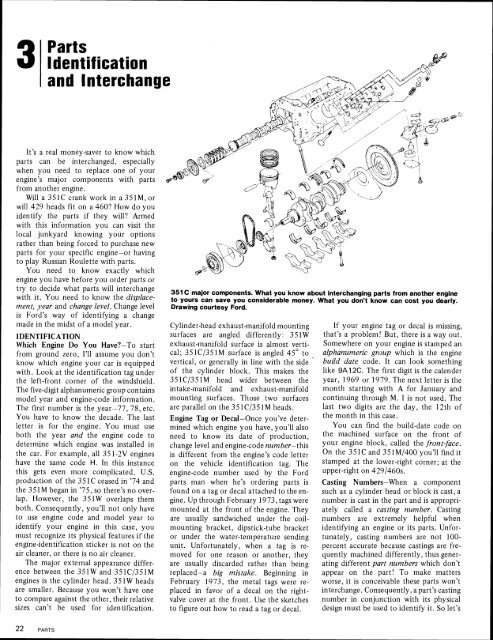How To Rebuild Your Ford V-8 351C-351M-400-429-460.pdf - Index of
How To Rebuild Your Ford V-8 351C-351M-400-429-460.pdf - Index of
How To Rebuild Your Ford V-8 351C-351M-400-429-460.pdf - Index of
You also want an ePaper? Increase the reach of your titles
YUMPU automatically turns print PDFs into web optimized ePapers that Google loves.
1 and Interchange<br />
It's a real money-saver to know which<br />
parts can be interchanged, especially<br />
when you need to replace one <strong>of</strong> your<br />
engine's major components with parts<br />
from another engine.<br />
Will a <strong>351C</strong> crank work in a <strong>351M</strong>, or<br />
will <strong>429</strong> heads fit 011 a 460 <strong>How</strong> do you<br />
identify the parts if they will Armed<br />
with this information you can visit the<br />
local junkyard knowing your options<br />
rather than being forced to purchase new<br />
parts for your specific engine-or having<br />
to play Russian Roulette with parts.<br />
You need to know exactly which<br />
engine you have before you order parts or<br />
try to decide what parts will interchange<br />
with it. You need to know the displacement,<br />
year and change level. Change level<br />
is <strong>Ford</strong>'s way <strong>of</strong> identifying a change<br />
made in the midst <strong>of</strong> a model year.<br />
IDENTIFICATION<br />
Which Engine Do You Have-<strong>To</strong> start<br />
from ground zero, 1'11 assume you don't<br />
know which engine your car is equipped<br />
with. Look at the identification tag under<br />
the left-front corner <strong>of</strong> the windshield.<br />
The five-digit alphanumeric group contains<br />
model year and engine-code information.<br />
The first number is the year-77,78, etc.<br />
You have to know the decade. The last<br />
letter is for the engine. You must use<br />
both the year and the engine code to<br />
determine which engine was installed in<br />
the car. For example, all 351 -2V engines<br />
have the same code H. In this instance<br />
this gets even more complicated. U.S.<br />
production <strong>of</strong> the <strong>351C</strong> ceased in '74 and<br />
the <strong>351M</strong> began in '75, so there's no overlap.<br />
<strong>How</strong>ever, the 351W overlaps them<br />
both. Consequently, you'll not only have<br />
to use engine code and model year to<br />
identify your engine in this case, you<br />
must recognize its physical features if the<br />
engine-identification sticker is not on the<br />
air cleaner, or there is no air cleaner.<br />
The major external appearance difference<br />
between the 351W and <strong>351C</strong>/<strong>351M</strong><br />
engines is the cylinder head. 351W heads<br />
are smaller. Because you won't have one<br />
to compare against the other, their relative<br />
sizes can't be used for identification.<br />
351 C major components. What you know about interchanging parts from another engine<br />
to yours can save you considerable money. What you don't know can cost you dearly.<br />
Drawing courtesy <strong>Ford</strong>.<br />
Cylinder-head exhaust-manifold mounting<br />
surfaces are angled differently: 351 W<br />
exhaust-manifold surface is almost vertical;<br />
<strong>351C</strong>/<strong>351M</strong> surface is angled 45" to<br />
vertical, or generally in line with the side<br />
<strong>of</strong> the cylinder block. This makes the<br />
351 C/3 51 M head wider between the<br />
intake-manifold and exhaust-manifold<br />
mounting surfaces. Those two surfaces<br />
are parallel on the <strong>351C</strong>/<strong>351M</strong> heads.<br />
Engine Tag or Decal-Once you've determined<br />
which engine you have, you'll also<br />
need to know its date <strong>of</strong> production,<br />
change level and engine-code number-this<br />
is different from the engine's code letter<br />
on the vehicle identification tag. The<br />
engine-code number used by the <strong>Ford</strong><br />
parts man when he's ordering parts is<br />
found on a tag or decal attached to the engine.<br />
Up through February 1973, tags were<br />
mounted at the front <strong>of</strong> the engine. They<br />
are usually sandwiched under the coilmounting<br />
bracket, dipstick-tube bracket<br />
or under the water-temperature sending<br />
unit. Unfortunately, when a tag is removed<br />
for one reason or another, they<br />
are usually discarded rather than being<br />
replaced-a big mistake. Beginning in<br />
February 1973, the metal tags were replaced<br />
in favor <strong>of</strong> a decal on the rightvalve<br />
cover at the front. Use the sketches<br />
to figure out how to read a tag or decal.<br />
If your engine tag or decal is missing,<br />
that's a problem! But, there is a way out.<br />
Somewhere on your engine is stamped an<br />
alphanumeric group which is the engine<br />
build date code. It can look something<br />
like 9A12C. The first digit is the calender<br />
year, 1969 or 1979. The next letter is the<br />
month starting with A for January and<br />
continuing thr0ugh.M. 1 is not used. The<br />
last two digits are the day, the 12th <strong>of</strong><br />
the month in this case.<br />
You can find the build-date code on<br />
the machined surface on the front <strong>of</strong><br />
your engine block, called the front-face.<br />
On the 35 1C and 35 1M/<strong>400</strong> you'll find it<br />
stamped at the lower-right corner; at the<br />
upper-right on <strong>429</strong>1460s.<br />
Casting Numbers-When a component<br />
such as a cylinder head or block is cast, a<br />
number is cast in the part and is appropriately<br />
called a casting number. Casting<br />
numbers are extremely helpful when<br />
identifying an engine or its parts. Unfortunately,<br />
casting numbers are not 100-<br />
percent accurate because castings are frequently<br />
machined differently, thus generating<br />
different part numbers which don't<br />
appear on the part! <strong>To</strong> make matters<br />
worse, it is conceivable these parts won't<br />
interchange. Consequently, a part's casting<br />
number in conjunction with its physical<br />
design must be used to identify it. So let's
















